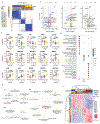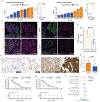Tumor-Intrinsic Kinome Landscape of Pancreatic Cancer Reveals New Therapeutic Approaches
- PMID: 39632628
- PMCID: PMC11805639
- DOI: 10.1158/2159-8290.CD-23-1480
Tumor-Intrinsic Kinome Landscape of Pancreatic Cancer Reveals New Therapeutic Approaches
Abstract
We provide a comprehensive tumor-intrinsic kinome landscape that provides a roadmap for the use of kinase inhibitors in PDAC treatment approaches.
©2024 American Association for Cancer Research.
Conflict of interest statement
Disclosures: Stefan Boeck COI (not related to project)
Consulting or advisory role: Celgene, Servier, Incyte, Fresenius, Janssen-Cilag, AstraZeneca, MSD, BMS; Honoraria for scientific presentations: Celgene, Servier, MSD
Patent holders of PurIST (WO2020205993A1), which is used in this study, who are authors: Naim Rashid, Jen Jen Yeh. GeneCentric Therapeutics, Inc. had no involvement in the current study but acquired an exclusive license from the University of North Carolina at Chapel Hill to PurIST for subtyping pancreatic ductal adenocarcinoma.
Figures






References
-
- SEER 5-year Relative Survival Rates, 2014-2020. [cited 2024 Nov 11]. Available from: https://seer.cancer.gov/statistics-network/explorer/application.html
-
- Conroy T, Desseigne F, Ychou M, Bouché O, Guimbaud R, Bécouarn Y, et al. FOLFIRINOX versus gemcitabine for metastatic pancreatic cancer. N Engl J Med. 2011. May 12;364(19):1817–25. - PubMed
MeSH terms
Substances
Grants and funding
LinkOut - more resources
Full Text Sources
Medical

